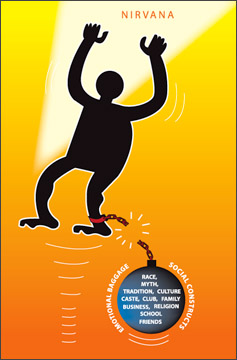Myth legitimizes religio/political identity
 Reflecting on the underlying theme of the Buddha's teachings of an
'I' less state ,one invariably begins to understand the significance of
non-identity in order to arrive there. The world of social constructs
cannot survive if not for a sense of identity which in a larger context
makes no sense at all, for identity itself ceases to be in the elegance
and finesse of Buddhist thought in arriving at the Nirvanic state.
However, as man's history is a constant quest for power, legitimizing
myth, tradition, beliefs and customs was an essential pre-requisite.
This then is not to disown all such for in its originality which bears
qualitative grandeur. Even so, in contextualizing such in what comprises
a higher purpose, its limitations are evident for it operates within the
framework of the senses. For instance let's take the custom of mutual
respect - the idea of respect or otherwise is purely a matter of feeling
and is very much into the state of 'I' - that 'I' exist which in the
Nirvanic context is a non-entity. Reflecting on the underlying theme of the Buddha's teachings of an
'I' less state ,one invariably begins to understand the significance of
non-identity in order to arrive there. The world of social constructs
cannot survive if not for a sense of identity which in a larger context
makes no sense at all, for identity itself ceases to be in the elegance
and finesse of Buddhist thought in arriving at the Nirvanic state.
However, as man's history is a constant quest for power, legitimizing
myth, tradition, beliefs and customs was an essential pre-requisite.
This then is not to disown all such for in its originality which bears
qualitative grandeur. Even so, in contextualizing such in what comprises
a higher purpose, its limitations are evident for it operates within the
framework of the senses. For instance let's take the custom of mutual
respect - the idea of respect or otherwise is purely a matter of feeling
and is very much into the state of 'I' - that 'I' exist which in the
Nirvanic context is a non-entity.
Legitimizing social constructs
 Legitimizing social constructs including what comes by way of myth is
to consolidate the existence of power, communities and even individuals.
All this and more crossed this writer's mind when listening to brilliant
historian Dr. Nirmal Ranjith Dewasiri whose almost three hour delivery
was a mental refreshner at the end of which the already half collapsed
world of social constructs crumbled down in toto which perhaps is the
aim of intellectual wonder. It made this writer understand how myths
certainly come into or rather are brought in to legitimize almost
anything and everything which is where the danger lies. Legitimizing social constructs including what comes by way of myth is
to consolidate the existence of power, communities and even individuals.
All this and more crossed this writer's mind when listening to brilliant
historian Dr. Nirmal Ranjith Dewasiri whose almost three hour delivery
was a mental refreshner at the end of which the already half collapsed
world of social constructs crumbled down in toto which perhaps is the
aim of intellectual wonder. It made this writer understand how myths
certainly come into or rather are brought in to legitimize almost
anything and everything which is where the danger lies.
The nation state formation with its fixed boundaries, territorial
integrity, sovereignty and what not have nothing to do with Islam,
Buddhism and Hinduism giving rise to the importance of a secular state.
The nation state characteristics itself have been brought in to
legitimize such state formation. Myth and tradition among other things
become twin partners in this legitimizing process. British historian
Eric Hobsbawn even spoke of traditions being invented for religio/political
identity.
In pre-nation state times of unfixed boundaries where national
identity of territorial integrity and sovereignty was unheard of there
was no need to legitimize existence. It was only in the 19th century
that the term nation came in as a political community. When a nation is
defined it becomes a spatial entity with groups of people residing in a
geographical space who are sovereign. Thereafter they try to find the
essence of their communities in the course of which myths come in to
legitimize their existence.
Poetry for ethnocentricity
Dr. Ranjith couldn't have said it any better for its reflection on
areas outside myth itself. For instance the 19th century nation state
formation also brought in the arts including poetry and literature that
eulogised highly volatile ethno centric and nationalistic sentiment all
of which was written and sung in the language of the majority community.
The religion of the majority was also brought in - the irony being
religion's goal being differently oriented. Thus the collision of a
spatial entity with that of what is sublime coming in the form of
religion has apart from other things such as marginalization and
exclusion even made the majority community come to cross roads with a
religion that preaches detachment colliding with the attachment of
worldly identity and increasing wants.
Getting back to Dr. Nirmal Ranjith Dewasiri's delivery on the myths
and its legitimization, he even said it was introduced for purposes of
political and religious identity.
'The Bhikkhus at the time when the Mahavamsa was written in 6th
Century AD had their own perceptions of political and religious
identity. In this chronicle, the Bhikkhus legitimized their kings as
warriors. He also said the Buddha's visit or the Dutugemunu/Elara
conflict were events that took place hundreds of centuries before the
chronicle writings. "For instance the Buddha's visit 12 centuries prior
to the chronicle writing and the Elara/Dutugemunu conflict that took
place 700 years before - now just imagine what sort of distortion could
come in between that huge time gap?" he asked.
Thus he believes the Mahavamsa chronicle as being manipulated into
much religio/political/social identity to uphold nationalistic and
majoritarian tendencies.
Nationalism he believes is all about an imagined community. Making a
distinction between the imagined community and the face to face one Dr.
Ranjith said, "The defining feature is we don't know many members of the
community. I simply imagine they exist. It's like this. I haven't been
to Ampara but I imagined the Sinhalese lived there. We dream of things
we know. We imagine those coming from Mars like UFOs. We even draw these
UFOs like we saw them."
Imagined community
"The nation too is an imagined community. Once we believed these
communities existed we have to legitimize it. The nation has spatial
existence. Right now as I talk the Sinhala people exist within a
geographical framework. This is not sufficient.
We have to give them a historical legitimacy - a temporal factor - a
kind of historical evolution must be given to legitimize."
"The Jews for instance were all over the world. But a strong
tradition of theirs was a centuries old origin dating back even to the
time of Moses - that they were the chosen people.
Elaborating all this at a personal level he said, "I can say I'm the
best intellectual. Then I create a myth that legitimizes my present
position. We go on creating stories that legitimize prevailing
conditions. These myths not only legitimize these conditions but all
practices as well inclusive of social/religious/cultural and economic.
Myths legitimize communities, the clergy, a state dynasty organisations
and all else.
Identity awareness
"The idea of identity came in as societies moved from the nomadic
state into sedentary agriculturists. Identities intensified with the
development of capitalism, big markets, revolutions that destroyed
empires and brought in the nation which later became political
identities. Nations in fact are political communities. The UN even
defines nation as an entity that has a right to self determination. The
nation being a political community defines its self in terms of
political characteristics. Sovereignty and territorial integrity are all
political concepts - part and parcel of identity.
This problem aggravates when geographical space comes in to
accommodate that political community. Then sets in exclusion. The way we
define Sri Lankan identity did not give opportunity for Tamils and
Muslims to be included in it. Our official definition of what this Sri
Lankan nation is does not end there. We further qualify Sri Lankanness.
Take for instance the Sri Lankan national flag. How do non-Sinhalese
view this? Are the Tamils as comfortable as the Sinhalese with this
flag. Do the Tamils and Muslims get sufficient sense of being included.
Only the majority define who can determine what to give them. How is
this lion symbol perceived by contending parties. Tigers versus lions -
does the lion signify Sinhalese or Sri Lankans. Is being Sri Lankan
inclusive of all communities or Sinhala exclusiveness. So there's
nothing Sri Lankan in the lion symbol. The two strips are therefore
trivial. If this is the state of the national flag, discrimination on
all fronts go without saying. We the majority first define the Tamils as
a group of people who don't have historical legitimacy as the Sinhalese.
We don't allow them to define their existence while we define ours. They
feel they have a different history than what the Sinhalese believe is
theirs. They create an identity which we don't like."
This brought to writer's mind the mutual creation of identity
followed by mutual hate of such identity - again the relative state sets
in due to the onset of identity itself which when seen bereft of such
emotional baggage leads us to sane and sublime thinking - namely sharing
and caring.
[email protected] |
